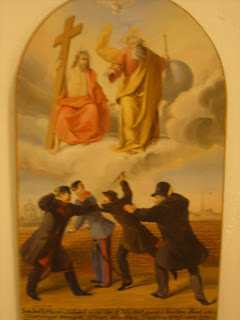 |
| Vienna Criminal Museum |
 |
| O'Donell's Cartridge case with Imperial seal |
 |
| Assassination attempt on Franz Josef- Divine Intervention |
 |
| Blood of Franz Josef on O'Donnell's glove |
Today after class Misha, Sheena, and myself went to check out the Crime museum. It was a private museum and had an overview of the history of crimes in Vienna. Probably one of the most famous crimes in Vienna to occur was the failed assassination attempt on the life of Franz Josef. While walking with one of his officers by the name of Maximilian O’ Donnell, a Hungarian nationalist named Janos Libenyi spotted the Emperor. He actually managed to stab Franz Josef in the back of the neck and many people believe that the collar of his shirt managed to save his life. O’Donnell who struck down Libenyi with his saber, had his glove stained with the blood of Emperor Franz Josef. Also kept here is O’Donnell’s cartridge pouch that carries the double-headed eagle, symbol of Hapsburg Austria. There hangs a painting depicting the failed assassination attempt with god and Christ pictured above on a cloud, calling out to warn Franz Josef. The work is entitled “the Salvation of Emperor Franz Josef” and shows that the ruler of the Austro-Hungarian Empire was spared because of the grace of god. This illustrated that because the assassination attempt failed, it was a miracle for the Empeor was stabbed in the neck; therefore he was spared by the grace of god. The museum is not for the faint of heart though. They were very graphic images of murder victims including the murders of small children. Vienna has long been at the forefront of criminal prevention. After World War I and the collapse of the Austro-Hungarian empire, Johann Schober was in charge of the Viennese police force which would come to be the most modern crime prevention unit during this time period. Criminology really seemed to begin in Vienna with the foundation of INTERPOL in 1923. One of the foremost individuals on counterfeit bank notes, Dr. Artur Klauser also worked with the Viennese police corps. Mouldings of murder victims and objects associated with crimes were pioneered by Dr. Poller of the Viennese police service and clearly illustrated how the Viennese were quite adept at perfecting the processes that would lead to solved criminal cases. It’s very eerie to see pictures of the people who were murdered and then actual items that were used by the criminals to wrap their bodies in and transport them. Misha, Sheena, and myself were emotionally drained afterwards because of the violent and brutal images on display. We came to the conclusion that although difficult to look upon an individual who had their life taken from them, it really can change a person’s attitude towards gratuitous violence. People tend to be de-sensitized to violence with its portrayal in mass media for example. However looking upon real people, who were brutally murdered by someone, results in a sad, yet strong personal connection with the victim. You are able to realize that this was someone who had their whole life in front of them and had it stolen away from them without warning. The personal connection leaves you feeling saddened and asking how could another person inflict such horrible brutality towards another human being?
No comments:
Post a Comment